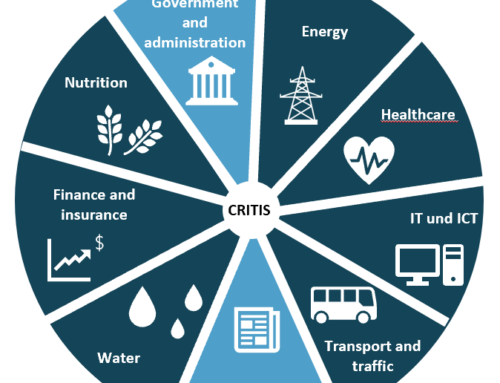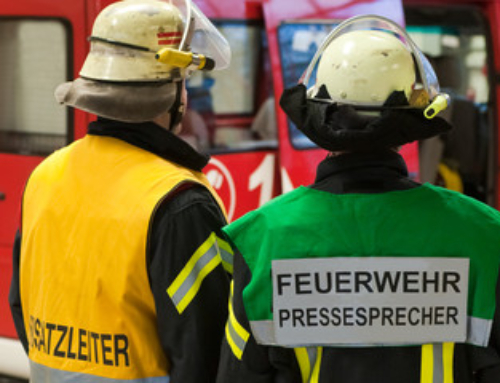A crisis team is a group of people with decision-making authority who plan and implement the management of a crisis. Other names are a staff for extraordinary events or a task force. No matter what such a group is called, it must have decision-making capability and be responsible for managing the crisis.
Fire Service Regulation 100 on Leadership and Command in Emergency Operations (German: Feuerwehr-Dienstvorschrift 100, FwDV 100 or DV 100) describes the crisis management team as it is used in emergency response (fire department, rescue service, disaster control/civil protection). Here, it is referred to as incident command staff. For more information on the distinction between the crisis management team and the command staff, you can read our blog article on the topic of “Leading – differences between BCM and official crisis management”.
The FwDV 100 was created after the Lüneburg Heath fire, as leadership faced great challenges during this fire. In some cases, emergency personnel were endangered, firefighting water was lacking, and fire departments and relief organizations from different federal states with different command and control systems were active in the operation. The FwDV 100 therefore standardizes command and control in emergency response, even across district and federal state borders, following the example of the military army service regulations.
Since the creation and publication of FwDV 100 in 1999, it has not been revised and is used in its current version by fire departments, rescue services and civil protection. In part, the aid organizations and individual federal states have made their own adaptations and thus created their own versions of DV 100, but these all contain the core content of FwDV 100.
The incident command staff of the FwDV 100 is structured as follows:

The incident commander assumes overall responsibility for the work of the staff and moderates the staff meetings. This function coordinates the staff and the other persons involved by delegating tasks to the departments. Each of these functional areas fulfills its own area of responsibility and must be staffed accordingly with a competent person capable of making decisions as the head of this area.
The S1 department is responsible for personnel planning and coordinates the alerting of additional emergency forces and their arrival at the scene of the incident.
Area S2 is responsible for documenting the situation. This means that all incoming information is sifted and documented in the staff. On the one hand, a mission diary is to be mentioned here, in which the course of the mission is described in writing. On the other hand, a description of the situation, e.g. the number of affected persons and the available resources, must also be recorded.
The S3 department assesses the situation according to the available information and makes the decision on the further course of action.
S4 is responsible for the logistics of the operation. This includes the alerting of resources as well as the provision of consumables, aids and other goods.
Section S5 is responsible for press and media relations and prepares and conducts communications with the public. If you want to hear how crisis communication works in the company, listen to our podcast on crisis communication.
Department S6 is responsible for telecommunications and accordingly all activities to establish communication via telephones, but also fax or internet. This includes the provision of suitable technology (e.g. telephones, computers, printers) as well as problem solutions that limit their use.
The field S7 Psychosocial Emergency Care was only integrated into the staff at a later date and is therefore not yet listed in the FwDV 100. S7 deals with the care of persons who have been psychologically stressed by an operation. In this context, both emergency forces and affected persons or relatives are cared for in order to come to terms with the events.
To support the departments, specialist advisors are called in to provide incident-specific expertise that cannot be provided by the heads of the departments. These are, for example, chemical experts who are called in for hazardous materials operations.
In addition, there may be liaison persons who act as a bridge between a company’s crisis team and the emergency response team. For example, in the event of a fire, the fire department sends liaison officers to support the company’s crisis management team and at the same time quickly obtain important information for firefighting.
The crisis team in the company
It may be possible to transfer such a staff system to companies, but adaptations are necessary and in some cases it may already be sufficient to manage the situation with smaller teams, which are supplemented by specialist advisors as required. In principle, it can also be assumed that the staff of FwDV 100 is unnecessarily complicated and too large for companies, but a comparable basic structure with defined areas of responsibility should be aimed for. As far as the size of a crisis team is concerned, it should be noted that the work becomes inefficient if more than ten people are involved.
For a crisis team to function in a company, it must have top decision-makers who make the decisions. Good staff work in this context means that the decisions are prepared and derived by the staff members. However, daily hierarchies can also be broken. For example, a decision-maker must be professionally as well as mentally suited for the job. Staff members should therefore have the following characteristics and competencies:
- Strong character
- Stress-resistant
- Experienced in their own field
- Possess procuration for decisions
The management of a department can therefore also determine that an employee is better suited for this task on the staff than they are, and by sending them to the staff, break the daily hierarchies. This realization demonstrates a strength on the part of the manager to recognize that other people can do the job better.
A staff should not be guided in its work by the fact that individuals radiate competencies that they may not possess. In so-called groupthinking, the opinion of individuals is relied upon by radiating competence without critically questioning decisions and statements. Especially in exercises, one person (taking turns) should therefore look at each decision critically and from different perspectives and express concerns.
To continue on the topic of exercises, it should be noted that a crisis team gains more experience with each exercise and cooperation between people improves. Also, the integration of new people into the crisis team, who represent deputies in the event of an incident, presents the team with new challenges, but at the same time also offers new experiences. In this way, the procedures can be trained and the strengths and weaknesses can be worked out. It makes sense to always involve new people in the staff, as Corona shows that an event is not always short-term and a replacement of staff members may become necessary. If trained people are missing, the staff must completely retrain after such a replacement, which can cost valuable time.
A crisis team should have a defined crisis team room available, which is used exclusively for the crisis team after the occurrence of an event. Appropriate preparation should include the availability of equipment (video projector, telephone, WLAN, LAN cables, etc.) and the provision of basic supplies such as cereal bars and drinks. Thus, the work of the staff can be guaranteed at any time of the day and is not additionally burdened by influences such as technical problems, as well as the basic needs.
The training of the crisis staff should start with training the basics of staff work and then testing different scenarios in recurring exercises. Starting with a manual procedure using a piece of paper and a pencil, it is possible to switch to software once a certain level of experience has been reached. However, without experience, this software requires additional training in its use, which takes up unnecessary time in the event of an incident. In addition, if you can handle an event with a pen and paper, you can also handle it with software and be prepared for a software failure at the same time.
A company should train a crisis team and put it into practice. With a basic course on the work of the crisis team, initial experience and knowledge can be gained, which can then only be consolidated and expanded through emergency drills. The goal in these drills should be to test the company’s plans for dealing with various crises and to see if they can work in a real situation. In addition to drills, training can also be conducted in which a trainer accompanies and observes the staff in the exercise and can thus provide feedback on the staff’s work.
In summary, education, training and exercises are important to prepare the crisis team for crises and the guiding principle for the creation of a good crisis team is: Practice! Practice! Practice!
If you would like to reorganize your company’s crisis team or test its capabilities in an emergency drill, we will be happy to assist you. Please also have a look at the offers of our Academy.
Literature
The fire department regulation 100 (FwDV 100)
Available online at: FwDV 100
An article written by Anna Müller, published on 05 August 2020
Translated by Charlotte Ley






